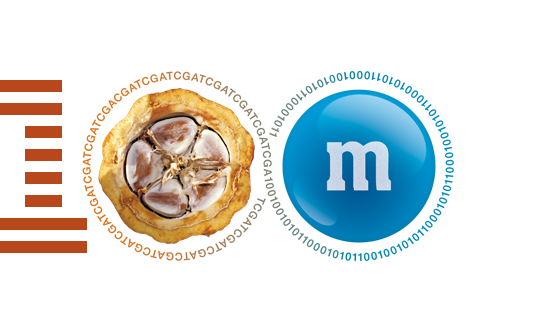Decoding the cocoa genome will help the development of the chocolate industry

In 2008, IBM and Mars formed a joint team to work on decoding the cocoa genotype. It should be noted that the decoding of the genotype of plants is not something new. Scientists have already received a genome map of rice, mustard and some other plants, including cocoa (2010).
The decoding of the cocoa genome was carried out with the aim of helping the cocoa growing industry to get more healthy, resistant to negative external factors, plants. The initial phase of this work ended with an interesting result: it turns out that the genome region responsible for the color of the plant can be an indicator of the health of the plant, as well as the taste of cocoa beans.
')
Why does the cocoa / chocolate industry need support?
• About 70% of the current cocoa crop is produced in equatorial Africa;
• 2 million small cocoa farms in West Africa depend on this plant;
• 1/3 of cocoa plantations in Africa is lost due to droughts, pests and fungal diseases;
• In the US alone, the “chocolate” industry loses $ 800 million as a result of the problems noted above.
How was the genome analyzed?
In order to sequence the cocoa genetic material, scientists took samples of leaves, pods and some other parts of the plant, sending it all to the laboratory of the US Agricultural Research Service (US Department of Agriculture). The DNA sequencer isolated the nucleotides necessary for the analysis. Well, the job of IBM, Mars, and the Ministry of Agriculture has already been to get the genome map. The work on decoding the cocoa genotype took three years, during the work more than 30 thousand genes were decoded.
After that, computer systems began to analyze these genes, using algorithms to identify specific gene patterns. In the course of the research, the team worked with samples of cocoa tissue from different parts of the world, trying to compare the genome of various cocoa species to identify critical sections of the genome responsible for the human properties of this plant, including taste, resistance to disease, lack of moisture and other factors.

According to Dr. Laxmi Parid, head of IBM’s computer genomics department, the most difficult part is finding the genes responsible for the phenotype . Breakthrough can be called the definition of genes responsible for the color of the pod.
Color, taste and genes
Scientists, during the lengthy work on sequencing the cocoa genome, were able not only to identify the genes responsible for the color of the cocoa pod, but also to understand where these genes are in the cocoa DNA.
Then the genes were labeled as “good” (for genes responsible for the green color of the pod), and “bad” (genes for the red color). It turns out that cocoa beans from green pods give a good taste, and from red ones - a bad one.

Now, with the help of the information received, you can get the best types of cocoa in a very short period of time. Previously, the work on the development of high-quality type of cocoa took years and years. Among other things, scientists are working to eliminate not only the types of cocoa that produce fruits with good taste, but also at the same time species that are resistant to negative external influences.
IBM's role in research
The corporation has developed algorithms for identifying genomic regions and individual genes in order to identify those genes that are responsible for the plant phenotype. This allows Mars to work effectively to improve cocoa flavor and plant resistance to external factors.
As for the IBM-developed algorithms , they are open to any community of researchers.
The cocoa genome is also made publicly available, a project has created its own website .
Source: https://habr.com/ru/post/234961/
All Articles